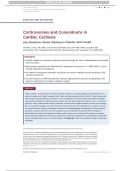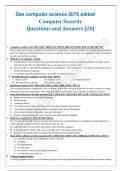JACC: HEART FAILURE VOL. -, NO. -, 2024
ª 2024 BY THE AMERICAN COLLEGE OF CARDIOLOGY FOUNDATION
PUBLISHED BY ELSEVIER
STATE-OF-THE-ART REVIEW
Controversies and Conundrums in
Cardiac Cachexia
Key Questions About Wasting in Patients With HFrEF
Onyedika J. Ilonze, MD, MPH,a Lauren Parsly Read-Button, RD, LDN, MPH,b Rebecca Cogswell, MD,c
Amy Hackman, MD,d Khadijah Breathett, MD, MS,a Edward Saltzman, MD,e Amanda R. Vest, MBBS, MPHf
HIGHLIGHTS
� Cardiac cachexia is common in patients with advanced HF and is independently associated
with mortality.
� We propose expanding the advanced HF recognition acronym to C-I-NEED-HELP, to aid
clinical implication recognition.
� No specific nonsurgical therapies are proven to reverse skeletal muscle wasting or the
cachexia syndrome.
� Current studies are defining optimal cachexia approaches in patients undergoing trans-
plant or mechanical circulatory support surgery.
ABSTRACT
Cardiac cachexia is characterized by unintentional catabolic weight loss, decreased appetite, and inflammation and is
common in patients with stage D (advanced) heart failure with reduced ejection fraction (HFrEF). Cardiac cachexia and
related muscle-wasting syndromes are markers of, and a consequence of, the heart failure (HF) syndrome. Although
many potential modalities for identifying cardiac cachexia exist, the optimal definition, diagnostic tools, and treatment
options for cardiac cachexia remain unclear. Furthermore, it remains unclear whether attempts to reverse muscle wasting
prior to advanced HF surgeries, such as left ventricular assist devices and heart transplantation, can improve outcomes.
It is important that HF clinicians and dietitians are aware of the pathophysiology and mechanisms of muscle-wasting
syndromes in patients with HF, to aid in the recognition and risk stratification of advanced HFrEF. Although the
opportunities and rationale for attempting to address cardiac cachexia prior to advanced HF surgeries are uncertain,
recent publications suggest that control of the neurohumoral syndrome of advanced HF may be important to permit the
recovery of skeletal muscle mass. (J Am Coll Cardiol HF 2024;-:-–-) © 2024 by the American College of Cardiology
Foundation.
From the aDivision of Cardiovascular Medicine, Krannert Cardiovascular Research Center, Indiana University School of Medicine,
Indianapolis, Indiana, USA; bFrances Stern Nutrition Center, Tufts Medical Center, Boston, Massachusetts, USA; cCardiovascular
Division, University of Minnesota, Minneapolis, Minnesota, USA; dHeart and Vascular Center, Brigham and Women’s Hospital,
Boston, Massachusetts, USA; eFriedman School of Nutrition Science and Policy at Tufts University, Boston, Massachusetts, USA;
and the fCardioVascular Center, Tufts Medical Center, Boston, Massachusetts, USA.
The authors attest they are in compliance with human studies committees and animal welfare regulations of the authors’
institutions and Food and Drug Administration guidelines, including patient consent where appropriate. For more information,
visit the Author Center.
Manuscript received August 23, 2023; revised manuscript received February 6, 2024, accepted March 12, 2024.
ISSN 2213-1779/$36.00 https://doi.org/10.1016/j.jchf.2024.03.003
,2 Ilonze et al JACC: HEART FAILURE VOL. -, NO. -, 2024
Controversies and Conundrums in Cardiac Cachexia - 2024:-–-
S
ABBREVIATIONS keletal muscle wasting and catabolic codes, where under-recognition of wasting by clin-
AND ACRONYMS weight loss are common in patients ical coding is a potential limitation. 10 Only 2.5% of
with heart failure with reduced ejec- primary left ventricular assist device (LVAD) re-
ActRIIB = activin receptor IIB
tion fraction (HFrEF) and are independently cipients were reported to have baseline cachexia in
ALM = appendicular lean mass
associated with mortality. 1-3 Cardiac cachexia the national Intermacs (Interagency Registry for
D3-Cr = deuterated creatine
is characterized by unintentional weight loss Mechanically Assisted Circulatory Support), where
DXA = dual x-ray caused by catabolism, which is the metabolic the lack of diagnostic criteria for this registry field
absorptiometry
state of fat and skeletal muscle mass break- was proposed to have significantly underestimated
FFM = fat-free mass
down to meet the energy needs of the cachexia prevalence. 9
GDF = growth differentiation
body. 4 The symptomatic impact of cardiac Intermediate rates of cardiac cachexia have been
factor
cachexia is increasingly recognized,5 and un- reported in studies based on unintentional edema-
HFrEF = heart failure with
reduced ejection fraction
intentional weight loss has been established free weight loss criteria. A 10.5% prevalence was
as a defining characteristic of the advanced observed for 238 HFrEF outpatients without diabetes
HT = heart transplantation
(stage D) HFrEF syndrome. 6 Although cardiac with NYHA functional class I-II and a mean age of 71
LVAD = left ventricular assist
device cachexia has been associated with a poor years, when defined by unintentional edema-free
US = ultrasound
prognosis since the 1990s,2 it remains unclear weight loss >5% over $6 months. 11 An 11.2%
whether targeted nutritional supplementa- cachexia prevalence was described in a cohort of 242
tion or other interventions can reverse muscle outpatients with NYHA functional class II-III HF,
wasting in the setting of the HFrEF syndrome and defined by $5% weight loss over 1 year (median age
whether treating cachexia could improve outcomes. 72 years, 61% were male), 12 whereas a 16% prevalence
Here we dissect the controversies and clinical conun- was reported for 11,712 clinical trial participants with
drums presented by cardiac cachexia, focusing on the mean age 65 years.13 A higher prevalence of 18.8%
mechanisms, clinical implications, and potential was reported among 207 ambulatory male patients
therapeutic strategies for reversal skeletal muscle based on unintentional edema-free weight loss $6%
wasting. The longer-term goal is to identify therapies over a year or more (mean age 67 years, mean NYHA
that improve functional capacity and survival for pa- functional class II).7 The reliance on unintentional
tients with HFrEF affected by catabolic weight loss. weight loss criteria in these studies makes them
vulnerable to under-recognition of wasting due to the
WASTING SYNDROMES IN PATIENTS WITH HF
potential for concurrent increases in fluid retention.
Sarcopenia can be diagnosed using various body
Cardiac cachexia, sarcopenia, and frailty are recog-
composition imaging methods or strength metrics. 3,14
nized as predictors of poor outcomes in patients with
Rates of skeletal muscle mass wasting using dual x-
HF. Overlap is common because they all share aging
ray absorptiometry (DXA) sarcopenia criteria specif-
and HF as predisposing factors and may be precipi-
ically in patients with HF range from 19.5% to 52%. 8,15
tated by worsening cardiac disease severity and
The point prevalence of sarcopenia was 19.5% in the
multisystem dysfunction (Figure 1). Despite being
SICA-HF cohort (mean age 70 years, predominantly
inter-related, each of these conditions has distinct
NYHA functional class II and III), 16 and 47% among
phenotypic criteria (Table 1). Among men with HF in
patients with cardiomyopathy aged <55 years (mean
the SICA-HF (European Studies Investigating
age 37 years, 51% NYHA functional class II or II-III). 17
Comorbidities Aggravating HF) study, only 6.7%
Prevalence is generally higher in cohorts with
subjects fulfilled both the cachexia and sarcopenia
decompensated or advanced HF. Sarcopenia was
criteria, but this subgroup showed the lowest
present in 52.6% of 38 patients admitted for acutely
strength, functional, and quality of life metrics.7
decompensated HF (mean age 75 years, 66% were
PREVALENCE OF WASTING SYNDROMES IN PATIENTS male).15 A 51.9% prevalence was observed in a cohort
WITH HF. The specific criteria used to define wasting of LVAD recipients with stage D HFrEF (27 patients
syndromes can substantially affect the prevalence underwent baseline DXA, mean age 56 years, 87%
within an HFrEF cohort, ranging as widely as 5% to were male).8
50%, with higher rates reported in cohorts with
greater HFrEF severity. Although a higher prevalence CLINICAL IMPLICATIONS OF WASTING SYNDROMES
may also be anticipated for patients of greater age and IN PATIENTS WITH HF. The seminal European report
longer HF disease duration, this has not been from 1993 to 1995 described 16% cachexia prevalence
consistently observed.8,9 A 7% cardiac cachexia rate among 171 outpatients with HF (mean age 60 years,
was reported from administrative data based on In- 90% were male) based on $7.5% unintentional weight
ternational Classification of Diseases–Tenth Revision loss over $6 months.2 Patients with cachexia had a
, JACC: HEART FAILURE VOL. -, NO. -, 2024 Ilonze et al 3
- 2024:-–- Controversies and Conundrums in Cardiac Cachexia
F I G U R E 1 Venn Diagram Representing Cachexia, Sarcopenia, and Frailty as Overlapping Syndromes
Cachexia, sarcopenia, and frailty are each associated with skeletal muscle wasting and decreased muscle strength to some degree, although
other associated symptoms and signs vary across the syndromes. Reproduced with permission from Burke MA. Quantifying the eyeball test:
grip strength at the nexus of frailty, cachexia and sarcopenia in heart failure. J Card Fail. 2023;29(6):919-921. https://doi.org/10.1016/j.
cardfail.2023.03.002. ADLs ¼ activities of daily living.
50% mortality at 18 months vs 17% for those without and poorer physical well-being, mobility, and usual
cachexia, and cachexia remained associated with activity scores (per the Functional Assessment of
mortality independent of other severity markers such Anorexia Cachexia Therapy Questionnaire and
as NYHA functional class and peak oxygen con- EuroQol-5 Dimension Questionnaire). 5
sumption.2 Similarly, the recent J-MELODIC (Japa- DXA-defined sarcopenia also has prognostic sig-
nese Multicenter Evaluation of Long- vs Short-acting nificance within the HF population.3,7 A SICA-HF
Diuretics for Congestive Heart Failure) cohort with analysis of 268 outpatients with NYHA functional
11.2% cachexia prevalence showed an independent class II-III HF recruited from 2010 to 2014 reported
association between cachexia and the composite of 17.5% prevalence of DXA-defined sarcopenia and an
cardiovascular mortality or HF hospitalization (HR: associated increase in mortality (HR: 1.80 [95% CI:
3.22 [95% CI: 1.10-8.41]; P ¼ 0.034).12 Broader diag- 1.01-3.19]; P ¼ 0.04), with the mortality effect being
nostic criteria incorporating weight loss, anthropo- more pronounced in HFrEF than heart failure with
metrics, strength, symptoms, and biochemistry were preserved ejection fraction (HFpEF).3 Sarcopenia was
used within a multicenter study from the United also associated with lower handgrip and quadriceps
Kingdom of 200 inpatients and outpatients with strength, 6-minute-walk distance, peak oxygen con-
NYHA functional class III-IV HF.5 Cachexia preva- sumption, and quality of life, as compared to the
lence was 15% and patients with cachexia reported patients with HF without muscle wasting. 7 The HF
significantly greater fatigue (based on the Functional prognostic implications of low skeletal muscle mass
Assessment of Chronic Illness Therapy fatigue scale) were corroborated by computed tomography imaging





